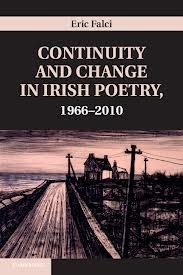Continuity and Change in Irish Poetry, 1966-2010 by Eric Falci

Given poetry's centrality in the Gaelic tradition, argues Eric Falci, it cannot help but make insistent references to history and the history of the Irish lyric. Falci, who is an associate Professor of English and the author of Continuity and Change in Irish Poetry, 1966-2010, engages in marvelously close readings to understand the importance of Ireland's oral and literary tradition in the work of its contemporary poets.
In cataloging the historical pressures placed on post-World War II poets, Falci goes back as far as early Ireland, to the social authority vested in the fili (bard, monk, or druid) whose role within the tuáth (tribe) was to praise, curse or satirize the ruler. If the bards held a privileged position in Irish culture as “the custodians of community histories,” they were also permitted the freedom to stand outside the rules of the community. Falci identifies other poetic inheritances through the ages, among them the nationalist, revivalist Celtic Twilight movement of the 19th and early 20th centuries; a history of dissent and exile; the uneven process of modernity due to Ireland’s entrance into the global economy in 1973, while the country's national liberation movements were still active; and of course the shadow of hyper-canonical figures like Yeats, Joyce, and later, Heaney. “Aesthetic autonomy has never quite been a possibility” given such a literary legacy, Falci notes, and contemporary poets have had to work with and against the Yeatsian injunction for Irish poets “to learn your trade.”
One of Falci's main arguments, then, is that "counter-moves" have pushed contemporary Irish poetry to evolve in line with, and past, its ancestry. Borrowing from the musical concept of counterpoint, Falci characterizes contemporary Irish poetry as “counterlyrics” that negotiate wildly contradictory impulses, committed doubly to the preservation and the undermining of the lyric genre. The events of the Troubles, beginning in 1968, adumbrate Falci’s account of the shift of the poetry scene from Dublin to Belfast, led by a group of poets who would pave the way for a Northern Irish literary renaissance in the following two decades. Falci's book features four of these key poets, mapping the conditions that shaped their works and the distinct "counterlyrical" strategies adapted by Paul Muldoon, Medbh McGuckian, Ciaran Carson and Nuala Ní Dhomhnaill. Offering a wealth of detailed, inductive explications of both poems and critical arguments undertaken by these poets, the middle chapters of the book examine the modes by which the poets of this transformative period sought to reinvent lyric subjectivity and the polemical figure of the Irish poet.
As an example of such a reading, Falci presents a striking stanza in Muldoon’s “Behold the lamb” illustrative of the way the "ingenious formalist" spins the politics of mourning quintessential to Irish poetry:
Better dead than sheep.
Falci observes that between the shift from "you" to "ewe," "the lamb’s death occurs in the gap between the massive semantic revision and the total lack of sonic difference.” He further shows how Muldoon manipulates Yeatsian rhetoric and a Heaneyesque tone of anxious moral responsibility through the poem, to orchestrate what the poet himself calls the “violent juxtaposition of the concepts of ‘Ireland’ and ‘I.’”
Then, highlighting the “aggressive anachronism” of McGuckian’s 1998 volume Shelmalier, which marks the bicentennial of the near-mythical 1798 Irish Rebellion, Falci explains that, unlike in Anglo-American modernism where poetry has moved away from the lyric to investigate history, in Irish modernity, poetry turns primarily to the lyric when looking at the past. McGuckian’s speaker skirts the line between historical appropriation and a self-reflective staging of it. She imagines the executed rebel Emmet via, Falci writes, a “carnival of pronouns”: “it is I who am only just left in flight, exiled / into an outline of time, I court his speech, not him.”
The readings of Carson focus on the way his poetry is conditioned by the urban grid and the dense surveillance network of Belfast in the '80s and '90s. Falci characterizes Carson's long poem “Queen’s Gambit” as a “fractious epic” through the labyrinthine city, with cinematic close-ups and long views, but “no mediating scale.”
Falci points out that Carson and the other poets are under-read in America. This is particularly true of Ní Dhomhnaill’s poetry, written and published in Gaelic before it is translated into English for a secondary edition. Arguing that Ní Dhomhnaill’s work demands a “translative reading strategy,” Falci places the onus of poetic complication not in the poems' production but in their reception and dissemination. Ní Dhomhnaill's dual-language books not only question the viability of translation and transcultural fluency, but also speak to the disappearance of the Irish language and its relationship to Irish identity. But as much as Ní Dhomhnaill’s folkloric, Gaelic poetry expresses an alternate mentality that cannot be elided into English, Falci brings attention to the poet's keen awareness that the written text itself (no matter the language) only mimics an oral tradition. If a translation into English is two steps removed from the oral wellspring of Irish poetry, then, that distance and removal, too, are entrenched in tradition.
Visit the Biblio-file to view books that shaped Professor Falci's thinking while working on Continuity and Change in Irish Poetry, 1966-2010.